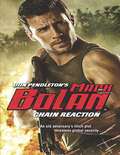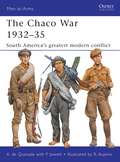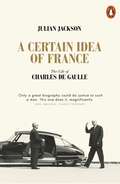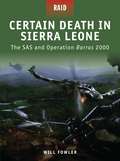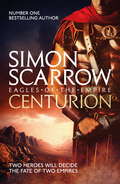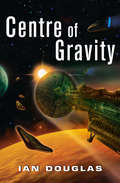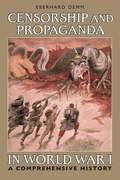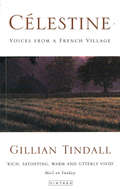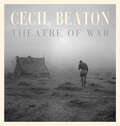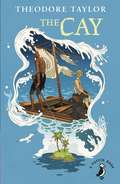- Table View
- List View
Challenge of Battle: The Real Story of the British Army in 1914 (General Military Ser.)
by Adrian GilbertWinston Churchill described the opening campaign of World War I as 'a drama never surpassed'. The titanic clash of Europe's armies in 1914 is one the great stories of 20th-century history, and one in which the British Expeditionary Force (BEF) played a notable part. Previous assessments of the BEF have held to an unshakeable belief in its exceptional performance during the battles of 1914. But closer examination of the historical record reveals a force possessing some key strengths yet undermined by other, significant failings. Within an authoritative and well-paced campaign narrative, Challenge of Battle re-evaluates the Army's leadership, organization and tactics. It describes the problems faced by commanders, grappling with the brutal realities of 20th-century warfare, and explains how the British infantry's famed marksmanship has to be set against the inexperience and tactical shortcomings of the BEF as a whole. However, it also demonstrates the progress made by the British during 1914, concluding with the successful defence of Ypres against superior enemy forces. The author examines the fateful decisions made by senior officers and how they affected the men under their command. Making full use of diaries, letters and other contemporary accounts, he builds a compelling picture of what it was like to fight in the battles of Mons, Le Cateau, the Aisne and Ypres. In this timely new book, Adrian Gilbert clears away the layers of sentiment that have obscured a true historical understanding of the 1914 campaign to provide a full, unvarnished picture of the BEF at war.
Challenge of Battle: The Real Story of the British Army in 1914
by Adrian GilbertWinston Churchill described the opening campaign of World War I as 'a drama never surpassed'. The titanic clash of Europe's armies in 1914 is one the great stories of 20th-century history, and one in which the British Expeditionary Force (BEF) played a notable part. Previous assessments of the BEF have held to an unshakeable belief in its exceptional performance during the battles of 1914. But closer examination of the historical record reveals a force possessing some key strengths yet undermined by other, significant failings. Within an authoritative and well-paced campaign narrative, Challenge of Battle re-evaluates the Army's leadership, organization and tactics. It describes the problems faced by commanders, grappling with the brutal realities of 20th-century warfare, and explains how the British infantry's famed marksmanship has to be set against the inexperience and tactical shortcomings of the BEF as a whole. However, it also demonstrates the progress made by the British during 1914, concluding with the successful defence of Ypres against superior enemy forces. The author examines the fateful decisions made by senior officers and how they affected the men under their command. Making full use of diaries, letters and other contemporary accounts, he builds a compelling picture of what it was like to fight in the battles of Mons, Le Cateau, the Aisne and Ypres. In this timely new book, Adrian Gilbert clears away the layers of sentiment that have obscured a true historical understanding of the 1914 campaign to provide a full, unvarnished picture of the BEF at war.
The Challenge of Abolishing Nuclear Weapons
by David KriegerIn the more than sixty years since the advent of nuclear weapons, there has been little meaningful progress toward nuclear disarmament. Some countries have nuclear weapons, while other states are forbidden to acquire them, a status quo that lacks rational basis and cannot be sustained. In this remarkable collection, scholars and policy analysts argue that humankind has a choice: either allow nuclear weapons to continue to proliferate throughout the world or move toward their complete elimination.The vast majority of people on the planet would surely opt to abolish nuclear weapons. But decisions about nuclear weapons are not made by the public, but by small groups of political elites. Consequently, in a world with nuclear weapons, the fate of humanity rests in the hands of a small number of individuals, whose perceptions, communications, and judgment determine whether there is to be a future.The contributors to this volume provide historical perspective on nuclear weapons policy; explore the role of international law in furthering the prospects of nuclear weapons abolition; consider the obstacles to abolition; present a path to achieving a nuclear weapons-free world; and look beyond abolition to consider issues of post-abolition sovereignty and general and complete disarmament. The goal of a nuclear weapons-free world can be awakened by an engaged citizenry bringing pressure from below in demanding action from political leaders. This book contributes to this awakening and engagement.
The Challenge of Abolishing Nuclear Weapons
by David KriegerIn the more than sixty years since the advent of nuclear weapons, there has been little meaningful progress toward nuclear disarmament. Some countries have nuclear weapons, while other states are forbidden to acquire them, a status quo that lacks rational basis and cannot be sustained. In this remarkable collection, scholars and policy analysts argue that humankind has a choice: either allow nuclear weapons to continue to proliferate throughout the world or move toward their complete elimination.The vast majority of people on the planet would surely opt to abolish nuclear weapons. But decisions about nuclear weapons are not made by the public, but by small groups of political elites. Consequently, in a world with nuclear weapons, the fate of humanity rests in the hands of a small number of individuals, whose perceptions, communications, and judgment determine whether there is to be a future.The contributors to this volume provide historical perspective on nuclear weapons policy; explore the role of international law in furthering the prospects of nuclear weapons abolition; consider the obstacles to abolition; present a path to achieving a nuclear weapons-free world; and look beyond abolition to consider issues of post-abolition sovereignty and general and complete disarmament. The goal of a nuclear weapons-free world can be awakened by an engaged citizenry bringing pressure from below in demanding action from political leaders. This book contributes to this awakening and engagement.
The Challenge: Britain Against America in the Naval War of 1812
by Andrew LambertIn the summer of 1812 Britain stood alone, fighting for her very survival against a vast European Empire. Only the Royal Navy stood between Napoleon's legions and ultimate victory. In that dark hour America saw its chance to challenge British dominance: her troops invaded Canada and American frigates attacked British merchant shipping, the lifeblood of British defence.War polarised America. The south and west wanted land, the north wanted peace and trade. But America had to choose between the oceans and the continent. Within weeks the land invasion had stalled, but American warships and privateers did rather better, and astonished the world by besting the Royal Navy in a series of battles.Then in three titanic single ship actions the challenge was decisively met. British frigates closed with the Chesapeake, the Essex and the President, flagship of American naval ambition. Both sides found new heroes but none could equal Captain Philip Broke, champion of history's greatest frigate battle, when HMS Shannon captured the USS Chesapeake in thirteen blood-soaked minutes. Broke's victory secured British control of the Atlantic, and within a year Washington, D.C. had been taken and burnt by British troops.Andrew Lambert, Laughton Professor of Naval History in the Department of War Studies at King's College London, brings all his mastery of the subject and narrative brilliance to throw new light on a war which until now has been much mythologised, little understood.
Chain Reaction
by Don PendletonElite 8th Wing pilot Celene Jur was taken captive after a mysterious device temporarily disabled her ship's controls. Three solar months later, when Celene receives intel on the man who built the device, she's ready to get the bastard.
The Chaco War 1932–35: South America’s greatest modern conflict (Men-at-Arms)
by Ramiro Bujeiro Alejandro De QuesadaThe Chaco War was massive territorial war between Bolivia and Paraguay, which cost almost a 100,000 lives. An old fashioned territorial dispute, the contested area was the Gran Chaco Boreal, a 100,000-square mile region of swamp, jungle and pampas with isolated fortified towns. The wilderness terrain made operations difficult and costly as the war see-sawed between the two sides. Bolivian troops, under the command of a German general, Hans von Kundt, had early successes, but these stalled in the face of a massive mobilization programme by the Paraguans which saw their force increase in size ten-fold to 60,000 men. This book sheds light on a vicious territorial war that waged in the jungles and swamps of the Gran Chaco and is illustrated with rare photographs and especially commissioned artwork.
The Chaco War 1932–35: South America’s greatest modern conflict (Men-at-Arms #474)
by Ramiro Bujeiro Alejandro De QuesadaThe Chaco War was massive territorial war between Bolivia and Paraguay, which cost almost a 100,000 lives. An old fashioned territorial dispute, the contested area was the Gran Chaco Boreal, a 100,000-square mile region of swamp, jungle and pampas with isolated fortified towns. The wilderness terrain made operations difficult and costly as the war see-sawed between the two sides. Bolivian troops, under the command of a German general, Hans von Kundt, had early successes, but these stalled in the face of a massive mobilization programme by the Paraguans which saw their force increase in size ten-fold to 60,000 men. This book sheds light on a vicious territorial war that waged in the jungles and swamps of the Gran Chaco and is illustrated with rare photographs and especially commissioned artwork.
Cesare: A Novel Of War-torn Berlin
by Jerome Charyn'Charyn's blunt, brilliantly crafted prose bubbles with the pleasure of nailing life to the page in just the right words. . . . Cesare is provocative, stimulating and deeply satisfying' - Washington PostOn a windy night in 1937, a seventeen-year-old German naval sub-cadet is wandering along the seawall when he stumbles upon a gang of ruffians beating up a tramp, whose life he saves. The man is none other than spymaster Wilhelm Canaris, chief of the Abwehr, German military intelligence. Canaris adopts the young man and dubs him 'Cesare' after the character in the silent film The Cabinet of Dr. Caligari for his ability to break through any barrier as he eliminates the Abwehr's enemies.Canaris is a man of contradictions who, while serving the regime, seeks to undermine the Nazis and helps Cesare hide Berlin's Jews from the Gestapo. But the Nazis will lure many to Theresienstadt, a phony paradise in Czechoslovakia with sham restaurants, novelty shops, and bakeries, a cruel ghetto and way station to Auschwitz. When the woman Cesare loves, a member of the Jewish underground, is captured and sent there, Cesare must find a way to rescue her.'A complex and detailed story of the inner workings of the German Third Reich during World War II... Highly recommended' - Library Journal'Charyn has created a terrific cast of original characters who speak in a language that reflects the selfish and predatory nature of that time... He tells a fascinating story of resistance against evil with a great deal of energy'- Historical Novels Review
A Certain Idea of France: The Life of Charles de Gaulle
by Julian Jackson'Masterly ... awesome reading ... an outstanding biography' Max Hastings, Sunday TimesThe definitive biography of the greatest French statesman of modern timesIn six weeks in the early summer of 1940, France was over-run by German troops and quickly surrendered. The French government of Marshal Pétain sued for peace and signed an armistice. One little-known junior French general, refusing to accept defeat, made his way to England. On 18 June he spoke to his compatriots over the BBC, urging them to rally to him in London. 'Whatever happens, the flame of French resistance must not be extinguished and will not be extinguished.' At that moment, Charles de Gaulle entered into history.For the rest of the war, de Gaulle frequently bit the hand that fed him. He insisted on being treated as the true embodiment of France, and quarrelled violently with Churchill and Roosevelt. He was prickly, stubborn, aloof and self-contained. But through sheer force of personality and bloody-mindedness he managed to have France recognised as one of the victorious Allies, occupying its own zone in defeated Germany. For ten years after 1958 he was President of France's Fifth Republic, which he created and which endures to this day. His pursuit of 'a certain idea of France' challenged American hegemony, took France out of NATO and twice vetoed British entry into the European Community. His controversial decolonization of Algeria brought France to the brink of civil war and provoked several assassination attempts.Julian Jackson's magnificent biography reveals this the life of this titanic figure as never before. It draws on a vast range of published and unpublished memoirs and documents - including the recently opened de Gaulle archives - to show how de Gaulle achieved so much during the War when his resources were so astonishingly few, and how, as President, he put a medium-rank power at the centre of world affairs. No previous biography has depicted his paradoxes so vividly. Much of French politics since his death has been about his legacy, and he remains by far the greatest French leader since Napoleon.
Certain Death in Sierra Leone: The SAS and Operation Barras 2000 (Raid)
by Howard Gerrard Mariusz Kozik Will FowlerIn September 2000 the notorious militia gang, 'West Side Boys' kidnapped eleven British soldiers in Sierra Leone and Operation Barras was launched as the rescue operation. Fast roping in from helicopters, the SAS soldiers engaged in a heavy firefight with the militia, killing several, and capturing their leader. Meanwhile the Paras advanced on foot, fighting their way through a village to recover the Land Rovers abandoned by the kidnapped soldiers. The operation was a complete success, with all the soldiers being rescued. This daring raid is brought to life with specially commissioned artwork, detailed maps and overhead shots to recreate one of the greatest hostage-rescue success stories.
Certain Death in Sierra Leone: The SAS and Operation Barras 2000 (Raid #10)
by Howard Gerrard Mariusz Kozik Will FowlerIn September 2000 the notorious militia gang, 'West Side Boys' kidnapped eleven British soldiers in Sierra Leone and Operation Barras was launched as the rescue operation. Fast roping in from helicopters, the SAS soldiers engaged in a heavy firefight with the militia, killing several, and capturing their leader. Meanwhile the Paras advanced on foot, fighting their way through a village to recover the Land Rovers abandoned by the kidnapped soldiers. The operation was a complete success, with all the soldiers being rescued. This daring raid is brought to life with specially commissioned artwork, detailed maps and overhead shots to recreate one of the greatest hostage-rescue success stories.
Centurion: Cato & Macro: Book 8 (Eagle #40)
by Simon ScarrowIF YOU DON'T KNOW SIMON SCARROW, YOU DON'T KNOW ROME!CENTURION, a no. 1 bestseller, is the unputdownable eighth novel in Simon Scarrow's Eagles of the Empire series. Perfect for fans of Bernard Cornwell and Conn Iggulden. 'A new book in Simon Scarrow's series about the Roman army is always a joy' The TimesAD 46. Roman army officers Cato and Macro have survived many dangerous missions together. They look out for one another. They're faithful to their Emperor. And from their men they demand bravery and ruthless efficiency.With the news that Rome's old enemy, Parthia, is poised to unleash its might against the border kingdom of Palmyra, Cato and Macro must embark on a desperate quest to protect the Empire. Outnumbered and deep in treacherous territory, they will have to endure a pitched battle that will test their courage and loyalty as never before...
Centre of Gravity: Star Carrier: Book Two (Star Carrier #2)
by Ian DouglasThe second book in the epic saga of humankind's war of transcendence
The Central Powers in the Adriatic, 1914-1918: War in a Narrow Sea
by Charles KoburgerThe naval side of the First World War in the Adriatic provides a classic case study in narrow sea warfare. This is the story of the Austro-Hungarian KuK Navy's contribution to the Central Powers' considerable effort in the region. This finely balanced, well-handled navy successfully helped to defend Austria's Adriatic base of power--the Pola-Trieste-Fiume triangle--in the north, to protect the vital sea lane to Cattaro and the south, and to support the army from the sea--all against major odds. Its forces also contributed significantly to the U-boat war.During initial stages of the conflict, the French were the enemy at sea. Later, Italy switched allegiances, joining the Entente against her former allies. Because the KuK Kriegsmarine was no match for the Italians and the French combined, the battle fleet was thereafter kept in being at Pola, holding the Allies in check. Nonetheless, the Adriatic became an Austrian lake. Using aircraft, U-boats, torpedoes, and mines, the KuK worked toward reducing the odds against it. However, the impasse would continue until the armistice, ruling out a Mahanian showdown in the Adriatic. Koburger provides important geostrategic points of comparison and valuable lessons for other conflicts, even today.
Central Asia in World War Two: The Impact and Legacy of Fighting for the Soviet Union
by Vicky DavisCentral Asia has long been situated at the geographical crossroads of East and West, once strategically located on the ancient Silk Road. The envy of the expanding Russian empire, it was colonized in the 19th century by Cossacks and traders from the north. This book examines how Central Asia, by then part of the Soviet Union, experienced population displacements on an even greater scale during the Second World War. Vicky Davis analyses how troops were sent westwards into action, only for waves of civilians to travel eastwards into the region: evacuees, refugees and even internal deportees sent into exile from their homelands in other parts of the vast Soviet Union. Central Asia in World War Two is the first book to tackle the subject of minorities fighting for the Soviet Union under Stalin in the Second World War. Based on meticulous archival research, it considers the interactions of the individual citizen and the Soviet state, weaving together the experiences of over three hundred ordinary men and women in Central Asia as they coped with their new roles on the front line or in the rear. Suffering incredible economic and physical hardship, racism and religious oppression, these mainly Muslim citizens were subjected to a forced process of Sovietization under the influence of Stalin's ubiquitous propaganda machine. Davis reveals how, while conscripts were all too often slaughtered or scapegoated in their regiments, the women and children left at home slaved in factories and communal farms to fuel the machinery of a war taking place thousands of kilometres away. She convincingly argues that the impact of forced assimilation, cultural indoctrination, anti-Semitism and re-education on the region were as great as the daily fight for survival in wartime. The legacy of the period is almost as complex, with struggles over the ownership and revision of history continuing even today.
Central Asia in World War Two: The Impact and Legacy of Fighting for the Soviet Union
by Vicky DavisCentral Asia has long been situated at the geographical crossroads of East and West, once strategically located on the ancient Silk Road. The envy of the expanding Russian empire, it was colonized in the 19th century by Cossacks and traders from the north. This book examines how Central Asia, by then part of the Soviet Union, experienced population displacements on an even greater scale during the Second World War. Vicky Davis analyses how troops were sent westwards into action, only for waves of civilians to travel eastwards into the region: evacuees, refugees and even internal deportees sent into exile from their homelands in other parts of the vast Soviet Union. Central Asia in World War Two is the first book to tackle the subject of minorities fighting for the Soviet Union under Stalin in the Second World War. Based on meticulous archival research, it considers the interactions of the individual citizen and the Soviet state, weaving together the experiences of over three hundred ordinary men and women in Central Asia as they coped with their new roles on the front line or in the rear. Suffering incredible economic and physical hardship, racism and religious oppression, these mainly Muslim citizens were subjected to a forced process of Sovietization under the influence of Stalin's ubiquitous propaganda machine. Davis reveals how, while conscripts were all too often slaughtered or scapegoated in their regiments, the women and children left at home slaved in factories and communal farms to fuel the machinery of a war taking place thousands of kilometres away. She convincingly argues that the impact of forced assimilation, cultural indoctrination, anti-Semitism and re-education on the region were as great as the daily fight for survival in wartime. The legacy of the period is almost as complex, with struggles over the ownership and revision of history continuing even today.
Censorship and Propaganda in World War I: A Comprehensive History (International Library of Twentieth Century History)
by Eberhard DemmThis book demonstrates how people were kept ignorant by censorship and indoctrinated by propaganda. Censorship suppressed all information that criticized the army and government, that might trouble the population or weaken its morale. Propaganda at home emphasized the superiority of the fatherland, explained setbacks by blaming scapegoats, vilified and ridiculed the enemy, warned of the disastrous consequences of defeat and extolled duty and sacrifice. The propaganda message also infiltrated entertainment and the visual arts. Abroad it aimed to demoralize enemy troops and stir up unrest among national minorities and other marginalized groups. The many illustrations and organograms provide a clear visual demonstration of Demm's argument.
Censorship and Propaganda in World War I: A Comprehensive History (International Library of Twentieth Century History)
by Eberhard DemmThis book demonstrates how people were kept ignorant by censorship and indoctrinated by propaganda. Censorship suppressed all information that criticized the army and government, that might trouble the population or weaken its morale. Propaganda at home emphasized the superiority of the fatherland, explained setbacks by blaming scapegoats, vilified and ridiculed the enemy, warned of the disastrous consequences of defeat and extolled duty and sacrifice. The propaganda message also infiltrated entertainment and the visual arts. Abroad it aimed to demoralize enemy troops and stir up unrest among national minorities and other marginalized groups. The many illustrations and organograms provide a clear visual demonstration of Demm's argument.
A Cellist Soldier
by Robert J. FanshaweA British Battalion moves up ready for the World War One 1917 battle of Arras. A much loved Regimental Sergeant Major is blown up, the man taking his place intensely disliked. A patrol is sent into No Man’s Land to rescue a casualty crying for help. One soldier, a cello player, throws his rifle away when the wrong casualty is shot in frustration. Threatened with Court Martial, he walks alone to find the real one, imagining playing his cello. He finds him, legs impossibly injured, pulls him from the mud and carries him towards a German medical station. The casualty, Sergeant John Wall, a real soldier shot for desertion in 1917, dies and the cello player is taken prisoner. He runs from the medical station wearing a red cross apron. On returning to his own line he is arrested. Witness a flawed Court Martial and a bizarre final ‘victory’ which is to have a profound effect on Ben the cellist’s friend and the fundamental question of justice in war.
The Cellist of Sarajevo: The Top 10 International Bestseller
by Steven GallowayThe Top 10 International BestsellerSnipers in the hills overlook the shattered streets of Sarajevo. Knowing that the next bullet could strike at any moment, the ordinary men and women below strive to go about their daily lives as best they can. Kenan faces the agonizing dilemma of crossing the city to get water for his family. Dragan, gripped by fear, does not know who among his friends he can trust. And Arrow, a young woman counter-sniper must push herself to the limits - of body and soul, fear and humanity. Told with immediacy, grace and harrowing emotional accuracy, The Cellist of Sarajevo shows how, when the everyday act of crossing the street can risk lives, the human spirit is revealed in all its fortitude - and frailty.
Celestine: Voices From A French Village
by Gillian TindallWhen Gillian Tindall discovered a cache of tightly folded letters in a deserted house in central France, recently emptied of 150 years of a family's possessions, she uncovered the obscure and moving life of one woman, Celestine Chaumette. This is Tindall's brilliantly original recreation of the vanished world of a French village.
Cecil Beaton: Theatre Of War
by Cecil BeatonAt the beginning of the Second World War the Ministry of Information, through the advice of Kenneth Clark, commissioned Cecil Beaton to photograph the Home Front. Beaton set to work recording the destruction of the Wren churches in the City and the heroism of Londoners under attack. He conducted a survey of Bomber and Fighter Commands for the RAF, which was published with Beaton's own astute commentary. Beaton was an effective propagandist, but his voice, like his photographs, was touchingly elegant. Whatever his subject, Beaton was always a stylist.Beaton's wartime work for the Ministry amounted to seven thousand photographs, which are now housed with their negatives at the Imperial War Museums. They form a great document both of the landscape of war and of the passing of the Empire. He travelled through the Western Desert and on to Iraq, Palestine, Transjordan and Syria. In 1943 he left for India where he photographed the final days of the Raj in New Delhi and Calcutta before joining the Burma campaign. He ended the war deep in Chinese territory where he witnessed the Nationalist resistance to the Japanese. Beaton's inherent sense of theatre extended from palatial drawing rooms to the jungle and the desert. Whatever the circumstances he never departed from his radical aesthetic. Theatre of War is published in conjunction with the Imperial War Museums on the occasion of a major exhibition.
The Cay (A Puffin Book #38)
by Theodore Taylor Kenny McKendryA tense and compulsive survival story of a young boy and an old man adrift on the ocean, then marooned on a tiny, deserted island. It is also a fascinating study of the relationship between Phillip, white, American, and influenced by his mother's prejudices, and the black man upon whom Phillip's life depends.
Cavendon Hall (Cavendon Chronicles #1)
by Barbara Taylor BradfordA sweeping saga set around the aristocratic Ingham family of Cavendon Hall and the Swanns who serve them, set on the eve of World War 1.




